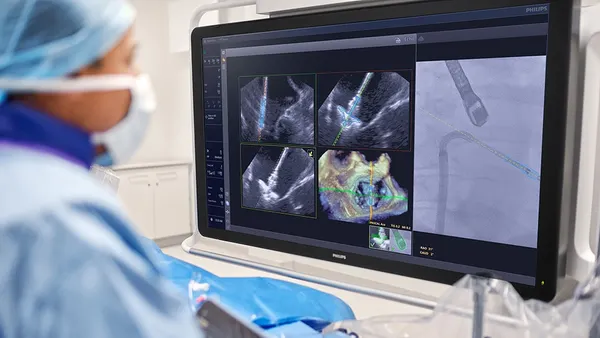Dive Brief:
- Edwards Lifesciences alerted customers last week it has received reports of burst balloons associated with the delivery system for its Sapien 3 Ultra transcatheter aortic valve replacement (TAVR) system that have caused significant difficulty removing the device from the patient's body.
- In the urgent field safety notice, shared by various international regulatory bodies, Edwards said the problem resulted in vascular injury, bleeding, difficulty removing the delivery system, or the need for surgical intervention in some patients. Edwards reported a complaint rate of 1%, of which 0.5% had "clinical implications" for patients. The company did not specify the number of injuries reported. No deaths were reported.
- The safety notice follows the recall less than a month ago of the company's IntraClude intra-aortic occlusion device after three deaths were linked to ruptured cardiovascular balloons used in those systems.
Dive Insight:
Issues with delivery systems for some of the company's heart devices have persisted. In addition to problems with the IntraClude device, Edwards earlier this month alerted customers that it had received reports of difficulties with manipulating its Centera TAVR system that were tied to vascular injury including aortic dissection and death.
Edwards won FDA approval for the Sapien 3 Ultra valve system in December for patients who have severe symptomatic aortic stenosis and are at intermediate or greater risk for open heart surgery. The device was designed with improvements to the valve and included a new delivery system meant to simplify the procedure.
In the urgent field safety notice, Edwards said valve deployment was successful in cases where complaints were filed. However, the burst balloons caused significant difficulty when retrieving the Sapien 3 Ultra delivery system into the sheath and removing it from the patient's body.
Two factors influenced the frequency of burst balloons: excess inflation volume and fast inflation conditions, the company said. It added that its investigations have not identified any evidence of devices that did not conform to specifications.
Edwards said a warning will be added to the Sapien 3 Ultra device stating that failure to use slow, controlled inflation and prescribed nominal inflation volumes may result in balloon rupture and difficulty retrieving the delivery system and could require conversion to surgical intervention.
The company instructs physicians deploying the valve to inflate the balloon slowly and continuously throughout deployment, then hold for three seconds at full inflation.
Bursting balloon catheters have also been a problem for device maker Cook Medical, which last month recalled three models used for leg angioplasty procedures after complaints related to the devices' rated burst pressure.








